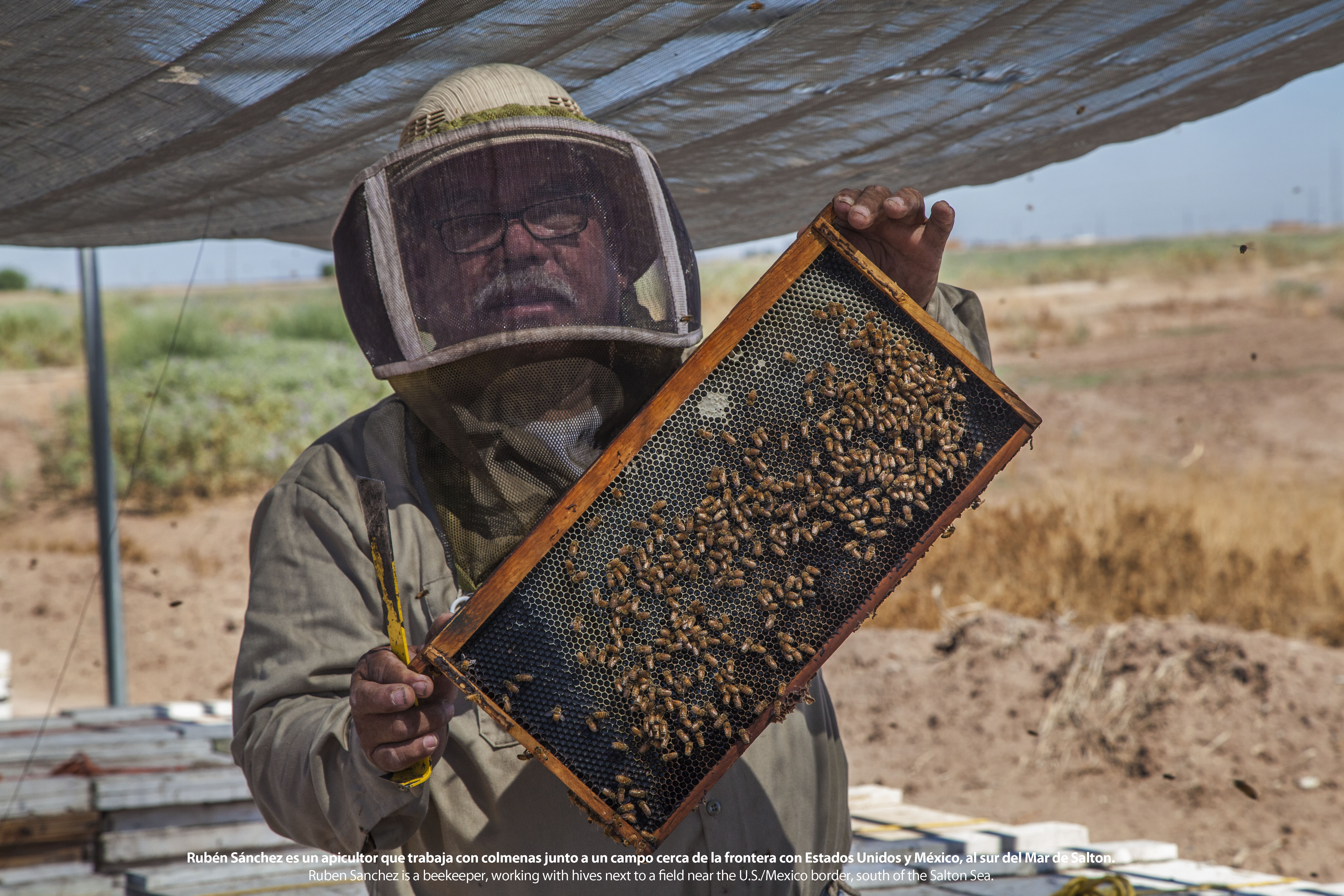by David Bacon
When the dust rises in North Shore, a small farmworker town at the edge of the Salton Sea, Jacqueline Pozar’s nose often starts bleeding. Her teacher at Saul Martinez Elementary School in nearby Mecca calls her mom, Maria, and asks her to come take her home.
Jacqueline is seven years old. “I feel really bad because I can’t do anything for her,” Maria Pozar says. “Even the doctor says he can’t do anything – that she’s suffering from the dust in the air. Most of the children in North Shore have this problem. He just says not to let them play outside.”
The children of North Shore are the proverbial canaries in the coal mine, whose sudden illnesses warn of a greater, life-threatening disaster to come. That disaster is the rapidly receding waters of the Salton Sea. As more and more playa – the sea’s mud shoreline – emerges from the water and dries out, fine particles get swept up by the wind and coat everything in its path, including children’s noses.
Airborne particles ranging in size between 10 and 1 p.m., are generated from wind-blown dust. When they lodge in the lungs, they can cause asthma and other illnesses.
This will be the biggest environmental disaster of our time,” charges Luis Olmedo, director of the Comite Civico del Valle, a community organization in the Imperial Valley at the Sea’s south end. “The issue of the Salton Sea trumps everything. We have to get the air contaminant level to zero. There is no safe level for the contaminants we have here. We need an intermediate project to stabilize the shoreline. The sea is receding much faster than any projects moving forward.”
The Salton seabed was created by the Colorado River millions of years ago. As it dug out the Grand Canyon, river sediment filled in a delta at the north end of the Gulf of California, creating what are now the Coachella and Imperial Valleys. Between those valleys lay an ancient geologic depression reaching a depth of 278 feet below sea level. Over the millennia it filled with water and then dried out repeatedly, but by the time of the Spanish colonization it was a dry desert saltpan.
In 1905, as Imperial Valley growers were building canals to bring Colorado River water to irrigate their farms, the levees containing their diversion failed when the river flooded. For two years the Colorado poured into the depression, creating the Salton Sea, whose surface rose over 80 feet above the desert floor.
Evaporation would eventually have dried it out, but in 1928 Congress designated land below -220 feet as a repository for agricultural runoff. Through the 1970s, the lake’s surface hovered at -227 feet, giving it an area of 378 square miles – the largest lake in California. Water from the Colorado, coming through the All-American Canal in the south and the Coachella Canal in the north, irrigated farmers’ fields and then went into the Sea, maintaining its level. Today the sediment lining the shore contains pesticides and fertilizer from decades of runoff.
The Salton Sea became a stopping point for more than 380 bird species migrating on the Pacific Flyway, including egrets, herons, gulls, eared grebes, white pelicans, Yuma clapper rails and gull-billed terns. The sea was stocked with fish species including corvina, sargo and bairdella. Tilapia introduced to control algae in irrigation canals also wound up in the lake.
Over the years the Salton Sea’s salinity increased, however, from 3,500 parts per million to 52,000 ppm – about 50 percent saltier than the ocean. Fish, except the tilapia, died off. Phosphorus and nitrogen from fertilizers, and nutrients stirred up by winds from the sea’s bottom, now create algae blooms that deplete oxygen, kill fish and contribute to diseases that kill birds. In 2012 the terrible stench from one algae bloom smothered Los Angeles for days, demonstrating that wind-borne dust may potentially travel that far as well. It can also blow south – across the border into Mexicali, Baja California’s capital city of more than 650,000 people.
In 2003 California was forced to reduce the water it takes from the Colorado to legal limits. As a result of an agreement hammering out how it would be shared, water began to be transferred from the Imperial Valley to San Diego. California Rural Legal Assistance warned the state plan “fails to comply with the California Environmental Quality Act.” At first valley growers agreed to fallow some fields, and the saved water continued to flow into the Sea. But this year fallowing ends, and water transfers to San Diego will rise sharply in December.
The California Natural Resources Agency says, “Inflow to the Salton Sea is expected to shrink significantly after 2017, when water transfers from the Imperial Valley accelerate and mitigation water deliveries stop under agreements reached years ago.” The 2003 agreement said the state would pay to restore the environmental health of the Sea, but for 13 years no money was appropriated. Imperial County, its air pollution district and local growers tried to challenge the agreement in court, but lost.
According to a 2005 Border Asthma and Allergies (BASTA) Study conducted by the California Department of Public Health, 20.2 percent of children in Imperial County are diagnosed with asthma. The national average is 13.7 percent. Imperial County consistently has the highest asthma hospitalization rates among all California counties, and ten valley residents died of it from 2000 to 2004.
Not all asthma is due to dust from the Sea. Even smaller particles, called PM 2.5, come from smoke from burning fields after crops are picked. The Comite Civico has pushed for banning field burning for many years, but “it’s cheaper for farmers to burn,” says Humberto Lugo, a Comite Civico staff member



